The Mystery of the Zapoteca Indian Gold Proclamation
by Alan Luedeking
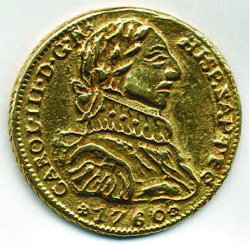
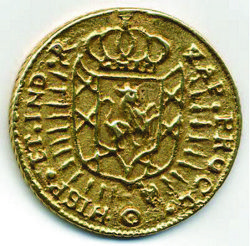
Obv.: Bust of Charles III, right; CAROL•III•D•G•R•HISP•ZAPTEC 1760 (Retrograde Z in ZAPTEC).
Rev.: Crude Arms of Oaxaca; HISP•ET•IND•R ZAP•PROCL •
Edge: Hand-filed diagonally reeded edge.
Gold, cast; 11.68 grams, dia. 26.2 to 26.5 mm.
Believed to be unique.
The piece illustrated above first caught my attention in the Aureo sale of 9 April 2003 Aureo Subastas Numismáticas, S. A., Subasta Numismática, 9 April 2003. The lot was described as unlisted in both Medina Medina, José Toribio, Medallas de Proclamaciones y Juras de los Reyes de España en América, Santiago, 1917 and Herrera Herrera y Chiesanova, Adolfo, Medallas de Proclamaciones y Juras de los Reyes de España, Madrid, 1882 (1884), which was in and of itself an attention getter. It is also a red flag, since both Medina and Herrera were meticulous researchers and vastly knowledgeable numismatists. But the listing did refer to Benjamin Betts’s work Some Undescribed Spanish-American Proclamation Pieces. So my first surprise came when I failed to find it in all three of these sources; but the explanation was simple: the piece was not in Betts’s main work dated 1898 Betts, Benjamin, Some Undescribed Spanish-American Proclamation Pieces, privately reprinted from American Journal of Numismatics, (Boston?), 1898 but in his Supplement of the same title dated 1900 Betts, Benjamin, Some Undescribed Spanish-American Proclamation Pieces – Supplement, privately reprinted from American Journal of Numismatics, [no place], 1900.
This could explain why Medina did not list it. None of the items in Betts’s Supplement appears in Medina’s works, which hints conclusively that Medina was unaware of this work, amazing considering that Medina did know of Betts’s main work, corresponded regularly with him and was so ardent a bibliophile. Another lesser possibility is that Medina knew the piece but considered it spurious and so ignored it.
In his listing, Betts states that he purchased the piece in Lyman Low’s sale of 20 February 1899, where it first surfaced. This explains why the piece was absent from Betts’s main work of 1898. The Low sale, where this piece appeared as lot 144, was described as being from the collection of Francisco de León y Calderón of Juárez, Oaxaca, Mexico. The price realized for this lot was $34, a not inconsiderable sum for the time.
The next logical step was to try and find it in subsequent sales of Betts material. The only such sale I am aware of is Lyman Low’s unnumbered (No. 136) of 16 December 1908, but I have had no luck locating it. Gengerke Gengerke, Martin, American Numismatic Auctions, November, 2002 does list two other sales of Betts material, but as both predate his acquisition of the piece in 1899 they are not relevant to this piece. Other sales I very much want to look through are Low’s González del Valle sales of 1907, which are rich in proclamation coins, although this piece is highly unlikely to be in them given that Medina references these sales extensively throughout his work yet, as mentioned, our Zapotecas piece is absent therein.
Meanwhile, I appealed to Aureo for more information and was rewarded with an interesting tidbit: although they did not reveal who their consignor was, they did forward to me a photocopy of a fragment of an article about the piece which I was finally able to identify from several clues as being from a 1995 article in Coin World, written by coin dealer Barry L. Fox of Reisterstown, Maryland. Fox, Barry L., “Unique Zapotecas proclamation gold piece resurfaces in market,” Coin World, Vol. 36, No. 1818, 13 February 1995 In this article Fox states that the coin was formerly in the collection of Colonel E. H. R. Green, and was reappearing on the market for the first time in 50 years.
I considered this assertion reasonable since Col. Green’s estate was dispersed in the early 1940s. This timing fit in nicely with Fox’s assertion that the piece was reappearing after 50 years. Unfortunately, the dispersal of Green’s numismatic estate did not occur at auction but privately, mostly through coin dealer Burdette G. Johnson. I now pursued a hunch: I learned that Hans Schulman had handled B. G. Johnson’s estate in his auctions nos. 7 and 8 of 1951 and 1952, so I searched through these sales, but did not find the piece. But I also learned that Johnson had dealt extensively with Schulman in earlier years, and that Schulman had previously dispersed much of Johnson’s numismatic estate (in 1948). Therefore, I decided to look at other Schulman sales, only to discover that there was a big hiatus in Hans Schulman’s auctions between 1942 and 1951! So, with a giant leap of faith I turned instead to Schulman’s fixed price lists, which he did issue within this time period. Lo and behold, I found the medal as lot No. 377 in Schulman’s fixed price list No. 25Schulman, Hans M. F., Important Catalogue No. 25, New York, (early 1944); this list is not dated but is attributable to early 1944. Herein Schulman attributes the piece to the Col. Green collection, stating that Green had purchased the coin for $750. Bingo! This confirmed dealer Barry Fox’s assertion in his 1995 article concerning the pedigree and timeline of the piece. Interestingly, Schulman lists the coin for just $195, a remarkable depreciation considering that Green supposedly acquired it for $750! Regrettably, Schulman did not mention when or from whom Green had purchased it. In his 1944 listing, Schulman makes a hash of describing the piece but leaves no doubt whatsoever as to its identity; this is the case primarily because in this listing he refers to an article on the piece that he intends to publish in the upcoming June 1944 edition of the Numismatic Review; this article did eventually get published, but not until the July issue. (This assertion of Schulman’s, incidentally, is one of the clues which helps to date Schulman’s undated fixed price list No. 25 to early 1944.) In the Numismatic Review article he plates the piece and this time describes it properly. He again states that the piece had once been in the Colonel E. H. R. Green collection, but adds no other significant information.
Next, thanks to the assistance of the profoundly knowledgeable numismatist Mr. Al Buonaguro, I learned that Schulman had again listed the piece for $175, as Lot No. 481, in his fixed price list No. 26 of 1946 Schulman, Hans M. F., A Superb Offering of Coins... 1946 Catalog No. 26, New York, 1946, this time referencing the earlier Numismatic Review article. In this listing he also invents that the arms on the reverse of the medal are of the Zapotecas Indians, when in fact the arms are those of the city of Oaxaca, Mexico in the 18th Century. (Below are examples of this coat of arms from other Oaxaca proclamation pieces. Note the crudity of the 1760 piece, the orientation of the lion, the X’s in the escutcheon and the retrograde P.)
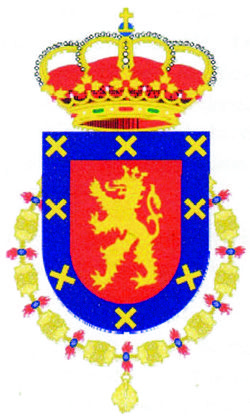
Colonial Coat of Arms of Oaxaca
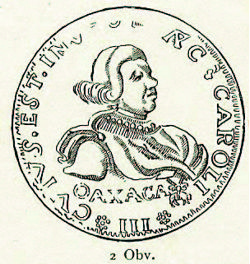
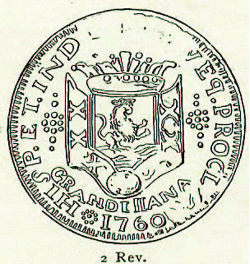
1760 Proclamation of Oaxaca, Betts No. 2. 1790
 Proclamation of Oaxaca, Herrera Pl. 63, No. 173
Proclamation of Oaxaca, Herrera Pl. 63, No. 173
Thereafter, all traces of the piece vanish until Barry Fox’s article of 1995.
Naturally, the next step was to contact dealer Barry Fox. Regrettably, this turned out to be impossible: I learned, after numerous telephone calls to coin dealers in the Reisterstown area that Mr. Fox had died in 1995, probably not long after his Coin World article appeared. I was told that Fox’s widow still kept his library and records intact, so I wrote to her with a detailed request for more information, enclosing a stamped, self-addressed return envelope, but regrettably never received a reply. One additional intriguing tidbit was revealed in the picture caption of the Coin World article: it said the image of the coin was “courtesy of Stack’s.” This hints at the possibility of the medal having been sold by Stack’s at some point before 1995, although most probably it refers to the Numismatic Review illustration of 1944Stack’s, Numismatic Review, Vol. 2, No. 1, New York, July, 1944, which was a Stack’s publication. I contacted Stack’s for further information, but none was forthcoming, even after offering to pay for their research time.
Following another hunch, I next contacted numismatist Eric Newman, who is known to have purchased many of Colonel Green’s gold coins, in the hopes he would remember this piece, and perhaps even have been its buyer. Mr. Newman replied in the negative, and the mystery continued.
Next, I appealed to Messrs. Clyde Hubbard and Holland Wallace, both exceedingly knowledgeable in the field of Latin American numismatics. They also were unable to offer further clues; however, Mr. Hubbard, one of the world’s foremost experts on Mexican coinage, hinted that the coin’s earliest pedigree troubled him, since Francisco de León y Calderón, the person who originally consigned the piece to Low’s sale in 1899, was presumably the brother of another gentleman from Oaxaca known to have been a counterfeiter. This information came as a huge shock to me. I next spoke to Mr. Mike Dunigan of Fort Worth, Texas, another numismatist whose knowledge of both colonial and republican Mexican coinage is profound. Mr. Dunigan was unequivocal in his condemnation of the piece for the same reason. Moreover, he went so far as to assert that virtually all (if not all) of the lots in the February 1899 Lyman Low sale were spurious, and informed me that this is a widely-held opinion among knowledgeable dealers and collectors, particularly of Mexican coinage. This assertion I have not attempted to confirm from other sources.
I have also heard that Hans M. F. Schulman’s attributions are not to be taken as gospel either, a perception that I fear is rather widely held in the numismatic community today.
This left me now with not only a mystery as to pedigree but, much worse, as to authenticity. Still, an argument can be made that the medal’s “style” might seem to fit in nicely with a cast proclamation piece of the era, and the colonial shield of Oaxaca is reasonably accurate. The “Zaptec” abbreviation is unusual for somebody trying to invent a heretofore unknown and unrecorded proclamation for collectors before 1899.
Nevertheless, it is worth reiterating that the piece is absent not only from the Medina and Herrera opuses but also missing in three of the world’s principal works on proclamation medals preceding these: Alejandro Rosa’s Aclamaciones (Buenos Aires, 1895), Hipólito Pérez Varela’s Ensayo (Havana, 1863) and Pedro Alonso O’Crouley’s Diálogos (Madrid, 1795).
In view of all the foregoing, I now incline towards considering the piece a fake. If anyone has any information to the contrary, I would be most desirous to know of it. Whether genuine or fake, the obtention of proof positive in either direction seems to present virtually insurmountable problems at this time, and each passing day can only render this more so.
Here then is the known and assumed pedigree of this unique piece, incomplete as it is:
Pedigree of, and references to, the only known (and possibly spurious) 1760 gold proclamation medal of the Zapoteca Indians of Oaxaca, Mexico:
• 1760 – 1898: Unknown (?)
• Before February 1899: Francisco de León y Calderón, of Juárez, Oaxaca, Mexico.
• Lyman Haines Low, Sale (#43), 20 February 1899, Lot 144. Price Realized $34. Sold to Benjamin Betts.
• Benjamin Betts, Some Undescribed Spanish-American Proclamation Pieces - Supplement, New York, 1900, p6, Plate II, No. 5.
• Benjamin Betts to Colonel E. H. R. Green (for $750?) between the early 1920s (when Green became active) and the early 1940s (?)
• Colonel E. H. R. Green possibly to Burdette G. Johnson (?)
• Burdette G. Johnson to Hans M. F. Schulman, by early 1944.
• Hans M. F. Schulman, Important Catalogue No. 25, (early 1944), p16, Lot #377, $175.
• Hans M. F. Schulman, “An Unrecorded Proclamation Gold Piece of the Zapotecas Nation”, in Numismatic Review, Vol. 2, No. 1, p17, New York, July 1944.
• Hans M. F. Schulman, A Superb Offering of Coins... 1946 Catalog No. 26, p31, Lot #481, $175.
• 1946 – ?: Hans M.F. Schulman to (unknown buyer)?
• Barry L. Fox, a Reisterstown, MD coin dealer, to a local Maryland family “years ago” (before 1995) according to an assertion in the Coin World article cited below.
• Barry L. Fox, “Unique Zapotecas proclamation gold piece resurfaces in market”, article in Coin World, February 13, 1995, p8.
• 1995: Barry L. Fox to ??
• 1995 to April, 2003: Not publicly known.
• 9 April 2003: Aureo Subastas Numismáticas, S. A., Subasta Numismática, lot 2063. Estimated at €2,000. Sold for €1,700 plus 16% buyer’s fee.
• 9 April 2003 – present: author’s collection.
